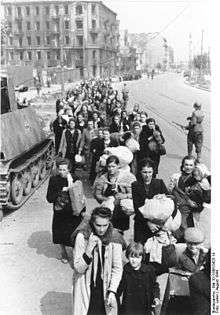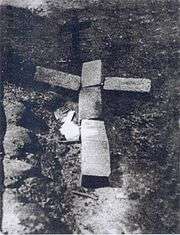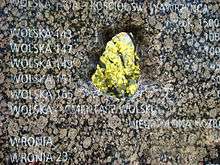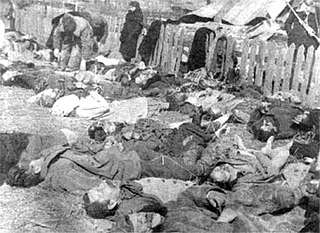Wola massacre
The Wola massacre (Polish: Rzeź Wola, "Wola slaughter") was the systematic killing of between 40,000 and 50,000 Poles in the Wola suburb of Poland's capital city Warsaw by German Wehrmacht and fellow Axis collaborators in the Russian RONA forces during the early phase of the Warsaw Uprising. The massacre was ordered by Hitler who directed to kill "anything that moves".
| Wola genocide | |
|---|---|
The Wola Genocide Memorial on Górczewska Street at the location of the railway embankment where up to 10,000 people were shot and then burned by the Germans between 5 and 8 August 1944 | |
| Location | Wola, Warsaw |
| Date | 5–12 August 1944 |
| Target | Poles |
Attack type | Genocide |
| Deaths | 40,000–50,000 |
| Perpetrators | |
| Motive | Anti-Polish sentiment, Germanisation, pan-Germanism |
From 5 to 12 August 1944, tens of thousands of Polish civilians along with captured Home Army resistance fighters were brutally and systematically murdered by the Germans in organised mass executions throughout Wola. Whole families perished including babies, children and old people. Germans murdered patients in hospitals, killing them in their beds. Doctors and nurses caring for them were also killed. Dead bodies were piled up to be burned. Before burning, dogs were let loose to check if anybody was still alive. If found alive they were killed on the spot. Black fires from the burning of thousands of bodies covered the whole suburb. Hundreds of women were raped and then killed. Parents were made to watch their children being killed and priests trying to protect those who sought refuge in churches were murdered, some at the altar.
The Germans anticipated that these atrocities would crush the insurrectionists' will to fight and put the uprising to a swift end.[1] However, the ruthless pacification of Wola only stiffened Polish resistance, and it took another two months of heavy fighting for the Germans to regain control of the city.
Massacre
The Warsaw Uprising broke out on 1 August 1944. During the first few days the Polish resistance managed to liberate most of Warsaw on the left bank of the river Vistula (an uprising also broke out in the district of Praga on the right bank but was quickly suppressed by the Germans). Two days after the start of the fighting, SS General Erich von dem Bach-Zelewski was placed in command of all German forces in Warsaw. Following direct orders from SS-Reichsfűhrer Heinrich Himmler to suppress the uprising without mercy, his strategy was to include the use of terror tactics against the inhabitants of Warsaw.[1] No distinction would be made between insurrectionists and civilians as Himmler's orders explicitly stated that Warsaw was to be completely destroyed and that the civilian population was to be exterminated.[lower-alpha 1][lower-alpha 2]
Professor Timothy Snyder, of Yale University, wrote that "the massacres in Wola had nothing in common with combat ... the ratio of civilian to military dead was more than a thousand to one, even if military casualties on both sides are counted."[2]

On 5 August, three German battle groups started their advance toward the city centre from the western outskirts of the Wola district, along Wolska and Górczewska streets. The German forces consisted of units from the Wehrmacht and the SS Police Battalions, as well as the mostly Russian SS-Sturmbrigade RONA and the SS-Sturmbrigade Dirlewanger, an infamous Waffen SS penal unit led by Oskar Dirlewanger.[3] British historian Martin Windrow described Dirlewanger's unit as a "terrifying rabble" of "cut-throats, [foreign] renegades, sadistic morons, and cashiered rejects from other units".[4]

Shortly after their advance toward the centre of Warsaw began, the two lead battle groups — Kampfgruppe "Rohr" (led by Generalmajor Günter Rohr) and Kampfgruppe "Reinefarth" (led by Heinz Reinefarth) — were halted by heavy fire from Polish resistance fighters. Unable to proceed forward, some of the German troops began to go from house to house carrying out their orders to shoot all inhabitants. Many civilians were shot on the spot but some were killed after torture and sexual assault.[5] Estimates vary, but Reinefarth himself has estimated that up to 10,000 civilians were killed in the Wola district on 5 August alone, the first day of the operation.[6] Most of the victims were the elderly, women and children.[7]
The majority of these atrocities were committed by troops under the command of SS-Oberführer Oskar Dirlewanger and SS-Brigadeführer Bronislav Kaminski.[8] Research historian Martin Gilbert, from the University of Oxford, wrote:
"More than fifteen thousand Polish civilians had been murdered by German troops in Warsaw. At 5:30 that evening [August 5], General Erich von dem Bach gave the order for the execution of women and children to stop. But the killing continued of all Polish men who were captured, without anyone bothering to find out whether they were insurrectionists or not. Nor did either the Cossacks or the criminals in the Kaminsky and Dirlewanger brigades pay any attention to von dem Bach Zelewski's order: by rape, murder, torture and fire, they made their way through the suburbs of Wola and Ochota, killing in three days of slaughter a further thirty thousand civilians, including hundreds of patients in each of the hospitals in their path."[9]

On 5 August, the Zośka battalion of the Home Army had managed to liberate the Gęsiówka concentration camp and to take control of the strategically important surrounding area of the former Warsaw Ghetto with the aid of two captured Panther tanks belonging to a unit commanded by Wacław Micuta. Over the next few days of fighting this area became one of the main communication links between Wola and Warsaw's Old Town district, allowing insurrectionists and civilians to gradually withdraw from Wola ahead of the superior German forces that had been deployed against them.
On 7 August, the German ground forces were strengthened further. To enhance their effectiveness, the Germans began to use civilians as human shields when approaching positions held by the Polish resistance.[10] These tactics combined with their superior numbers and firepower helped them to fight their way to Bankowy Square in the northern part of Warsaw's city centre and cut the Wola district in half.
German units burned down two local hospitals with some of the patients still inside. Hundreds of other patients and personnel were killed by indiscriminate gunfire and grenade attacks or selected and led away for executions.[11] The greatest number of killings took place at the railway embankment on Górczewska Street and two large factories on Wolska Street — the Ursus Factory at Wolska 55 and the Franaszka Factory at Wolska 41/45 — as well as the Pfeiffer Factory at 57/59 Okopowa Street. At each of these four locations, thousands of people were systematically executed in mass shootings, having been previously rounded up in other places and taken there in groups.
Between 8 and 23 August the SS formed groups of men from the Wola district into the so-called Verbrennungskommando ("burning detachment"), who were forced to hide evidence of the massacre by burning the victims' bodies and homes.[12] Most of the men put to work in such groups were later executed.
On 12 August, the order was given to stop the indiscriminate killing of Polish civilians in Wola. Erich von dem Bach issued a new directive stating that captured civilians were to be evacuated from the city and deported to concentration camps or to Arbeitslager labour camps.
Aftermath


No one belonging to the German forces who took part in the atrocities committed during the Warsaw Uprising was ever prosecuted for them after the end of the Second World War. The main perpetrators of the Wola massacre and similar massacres in the nearby Ochota district were Heinz Reinefarth and Oskar Dirlewanger. Dirlewanger, who presided over and personally participated in many of the worst acts of violence, was arrested on 1 June 1945 by French occupation troops while hiding under a false name near the town of Altshausen in Upper Swabia. He died on 7 June 1945 in a French prison camp at Altshausen, probably as a result of ill-treatment by his Polish guards.[13][14][15] In 1945, Reinefarth was taken into custody by the British and American authorities but was never prosecuted for his actions in Warsaw, despite Polish requests for his extradition. After a West German court released him citing a lack of evidence, Reinefarth enjoyed a successful post-war career as a lawyer, becoming the mayor of Westerland, and a member of the Landtag parliament of Schleswig-Holstein. The West German government also gave the former SS-Obergruppenführer a general's pension[16] before he died in 1979.
In May 2008, a list of several former SS Dirlewanger members who were still alive was compiled and published by the Warsaw Uprising Museum.[17]
See also
- Military history of the Warsaw Uprising
- Nazi crimes against ethnic Poles
- Tchorek plaques#Wola
Notes
- "[...] The Führer is not interested in the further existence of Warsaw [...] the whole population shall be executed and all buildings blown up. Madajczyk 1972, p. 390
- According to evidence given by Erich von dem Bach at the Nürnberg trial, Himmler's order (issued on the strength of an order from Adolf Hitler), read as follows: 1. Captured insurrectionists shall be killed whether or not they fight in accordance with the Hague Convention. 2. The non-fighting part of the population, women, children, shall also be killed. 3. The whole city shall be razed to the ground, i.e. its buildings, streets, facilities, and everything within its borders. Wroniszewski 1970, pp. 128–29.
References
- THE SLAUGHTER IN WOLA Archived 21 August 2009 at the Wayback Machine at Warsaw Uprising Museum
- Snyder, Timothy (2010). Bloodlands: Europe Between Hitler and Stalin. Bodley Head. p. 304. ISBN 0224081411.
- Lukas, Richard C. (2012). The Forgotten Holocaust: The Poles under German Occupation, 1939-1944. Hippocrene Books. p. 197. ISBN 978-0-7818-1302-0.
- Windrow, Martin & Francis K. Mason (2000). The World's Greatest Military Leaders. Gramercy. p. 117. ISBN 0517161613.
- Zaloga, Steven J. & Richard Hook (1982). The Polish Army 1939–45. Osprey Publishing. p. 25. ISBN 0-85045-417-4.
- "The Rape of Warsaw". Stosstruppen39-45.tripod.com. Retrieved 3 February 2009.
- Lukas, Richard (1997). Forgotten Holocaust. The Poles under German Occupation 1939–1944. Hippocrene Books, New York. ISBN 0-7818-0901-0.
- "Warsaw Uprising of 1944: PART 5 – "THEY ARE BURNING WARSAW"". Poloniatoday.com. 5 August 1944. Archived from the original on 28 January 2008. Retrieved 3 February 2009.
- Gilbert, Martin (2004). The Second World War: A Complete History. Owl Books. p. 565. ISBN 0-8050-7623-9.
- "1944: Uprising to free Warsaw begins". BBC News. 1 August 2002.
- (in Polish) Służba sanitarna w Powstaniu Warszawskim: Wola, SPPW1944
- "Timeline". Warsaw Uprising. Retrieved 3 February 2009.
- Walter Laqueur, Judith Tydor Baumel (2001). Dirlewanger, Oskar. The Holocaust Encyclopedia. Yale University Press. p. 150. ISBN 0300084323. Archived from the original on 29 October 2013. Retrieved 24 June 2012.
- Wistrich, Robert S. (2001). Who's Who of Nazi Germany: Dirlewanger, Oskar. Routledge, p. 44. ISBN 0-415-26038-8.
- Walter Stanoski Winter, Walter Winter, Struan Robertson. Winter Time: Memoirs of a German Sinto who Survived Auschwitz. 2004. Page 139. ISBN 1-902806-38-7.
- "Syn warszawskiej Niobe". polskatimes.pl. 31 July 2009. Retrieved 6 December 2012.
- Odkryta kartoteka zbrodniarzy, Rzeczpospolita, 17 May 2008.
External links
| Wikimedia Commons has media related to Wola Massacre. |
- Witness testimony on German massacre of Polish hospital patients
- Witness testimony on German massacre of Polish civilians in Wola
- (in German) Nacht über Wola, Der Spiegel 1962
- Genocide in Wola - a district sentenced to death - collection of civilian testimonies from "Chronicles of Terror"
- Unraveling a 70-Year-Old Photographic Mystery - Tereska, the girl from famous David Seymour's photography, revealed to be a survivor of the Wola Massacre
- The forgotten genocide - Wola massacre by Piotr Gursztyn
